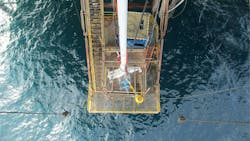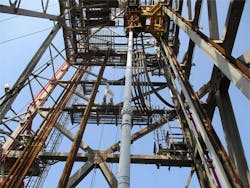A new approach reinvents shallow-water subsea well intervention
Editor's note: This article first appeared in the 2024 Offshore Business Strategies Special Report, which published within the May/June 2024 issue of Offshore magazine.
By Ben Cannell, Aquaterra Energy
Shallow-water subsea well intervention (to increase or restore production or to plug and abandon the well) is neither new nor especially exciting, as offshore engineering goes. However, it is a prime opportunity to burn cash if not approached optimally, which is increasingly common as the economic environment spurs operators to work economic assets harder and for longer, while also ensuring safe abandonment. Therefore, now is the right time to reassess the "standard" approach to shallow-water subsea well intervention.
Appetite for intervention
Best practice for well intervention must be informed by the profile of the well stock. Most subsea wells are decades old. In the UK, the North Sea Transition Authority (NSTA) cites an average subsea and platform well age of 22 years for the UK Continental Shelf (UKCS). Most wells, especially oil producers, require some sort of intervention about every five years. Over the last 15 years, more than 1,500 subsea trees have been installed in shallow-water depths (<500m) globally, with 50% of these in jackup drilling depth (<150m). Looking at the forecast for the next 10 years, more than half (54%) of all expected shallow-water subsea tree installs are expected to be jackup rig accessible.
This means there are a vast number of subsea wells of a prime age for intervention or abandonment work, mainly located in shallow waters. It also can be deduced—given the age profile—that many of these would have been installed using a moored semisubmersible with an early generation blowout prevention (BOP) system, which are much lighter than today’s equivalents and therefore able to have acceptable operational envelopes.
This is a cause for concern. Many of these wells may not be designed for the operational loads exerted by a current generation semisub deployed system with its significantly heavier BOP stack; even light well intervention vessels (LWIVs) may be on the borderline of suitability with subsea pressure control stacks often extending 60 TE. There may prove to be a rather limited supply of suitable semisub and vessel deployed intervention options for shallow-water subsea wells.
This would not necessarily be a major problem if well intervention work remained a niche activity. However, the opposite is true. In the UKCS, for example, the NSTA reports that 2022 saw an overall decrease in wells from 2,650 to 2,567, but notably, the number of shut-in wells also decreased from 785 to 743, indicating that operators are responding to higher commodity prices by restoring existing wells for production. This trend is expected to continue; well reentry and intervention can be a far more cost (and emission) effective approach then fresh projects. What’s more, they are faster, with time taken to deliver a project measured in months rather than years.
A more balanced approach
There is an obvious but, so far, underutilized alternative: subsea well intervention from jackups or lift boats. Jackups offer a number of inherent advantages for shallow-water work. Notably, they offer greater control over the operational load transferred to the well than semisubs or LWIVs equipped with a riser system. Floating vessel or semisub intervention by nature creates greater dynamic riser movement and offset to the well, which in turn creates high bending moments and fatigue damage into the subsea production assets.
These dynamics and vessel offsets are greatly exaggerated in shallow water due to the short span between the riser at the top of the subsea pressure control equipment and the vessel or semisub.
For some projects, the increased fatigue damage and bending moments may not even be the most limiting factor; emergency subsea closure and disconnection reaction speed often is operationally prohibitive in shallow waters or necessitates a vanishingly small operational weather window to complete the planned intervention activities. Such emergency shut-ins and disconnections, while they prevent overloading critical subsea equipment, pose an environmental hazard.
By anchoring to the seabed, a jackup or lift boat is inherently more stable, with very little offset from the well. This reduces loading and fatigue damage to an extent that can be difficult to match with even the best semisub or vessel dynamic positioning systems. Further, as a jackup or lift boat has no drift-off hazard, subsea well shut-in and disconnection reaction time is not a restrictive consideration, greatly improving operational uptime.
This can also make jackups cheaper (dynamic positioning systems and anchoring are expensive) and potentially safer with lower environmental risk. The lower downtime and bigger operational window can also mean less overall rig time, reducing costs and emissions.
Crucially, they are plentiful. As of early February, Westwood Global Energy Group counts 409 jackups in operations worldwide, versus 152 floating rigs. It is relatively easy and cost-effective to rent and mobilize a jackup or lift boat for shallow-water work anywhere in the world.
Therefore, jackups and lift boats may often be the sensible option for subsea well intervention work. However, unlike semisubs and LWIVs, they are not often readily equipped and crewed to carry out such intervention work. Therefore, they require fitting out by specialist engineering service companies offering subsea intervention equipment tailored for this niche environment.
To bridge this gap, Aquaterra Energy has developed a 5-inch to 14-inch ID, access riser-based intervention system designed to be deployed from jackups, LWIVs and semisubs fully, compliant with ISO1368-7 and API 17G, the completion and workover codes. The company also has provides specially designed jackup and lift boat compatible subsea intervention pressure control equipment, surface control equipment, tensioning, and other rig interface equipment and services. Its CWOR system, complete with AQC-CW connectors, is one of very few systems that meets or exceeds the requirements of ISO1368-7 and API 17G. It also features a simple radial bolt seal ring design that does not require specialist make up crews or equipment.
Beware false economy
Other approaches are possible, and the temptation is to go as lean as possible to keep costs low. However, operators must balance this with the risk of unforeseen circumstances, which may tip such approaches into false economy.
For example, wire through-water and riserless setups are extremely cost effective and can be deployed via LWIVs—assuming all goes smoothly, that is. If, however, the operator reenters the well on slickline or E-line and finds issues that call for some pumping or coil tubing work, then a riser is needed.
This means demobilizing and returning with a riser-based system, incurring substantial costs plus delays. When the bulk of the cost is tied up in the time taken to mobilize and demobilize (the intervention work itself is typically relatively quick), this can majorly skew project economics. Other risks are present with wire through water operations, especially where riser systems are not deployed.
By contrast, a jackup or lift boat deployment or a LWIV or semisub deployed CWOR means the operator is prepared for such eventualities while still running a relatively lean operation—a balanced approach that accounts for the high number of unknowns when reentering a well. This is important on a single well intervention campaign where such mobilization and demobilization costs cannot be split between multiple wells or companies.
A new best practice
Subsea development from jackups is now a standard approach for NOCs, oil majors and independents. The conversion equipment, riser systems and well control systems are well known and understood by regulators, drilling contractors and operators. However, standardized jackup or lift boat subsea intervention pressure control equipment and riser systems is a much less developed area.
With project economics relentlessly tight and reentry and intervention work unlikely to subside anytime soon, operators must be alert to where business-as-usual diverges from updated best practice. Agility of deployment and flexibility of function are the name of the game for cost-effective subsea well intervention and abandonment. Currently, jackup and lift boat deployed solutions are underutilized within the industry but are a potent approach to project success.
About the Author

Ben Cannell
Ben Cannell serves as innovation director at Aquaterra Energy. He is a Chartered Fellow of the Management Institute (CMgr FCMI) and holds a First Class Honors Degree in Engineering Management from the University of Lincoln.
He is responsible for driving innovation across Aquaterra's oil & gas and energy transition service and product lines. He has spearheaded the development and launch of numerous riser/subsea related products to date, including the company's 15k PSI AQC-SR and CW connectors, legacy well re-entry and abandonment services for CCS and the digitalization of both existing and new services.
Cannell began his offshore career with Schlumberger E Line in 2002 where he held various roles throughout that time, ranging from multiline memory production and cement bond logging, to perforating, well control and open hole logging. In 2008 he left Schlumberger to join Aquaterra Energy as a project engineer, responsible for delivering riser systems and associated equipment for subsea drilling and completion programs.

